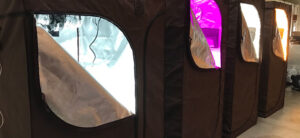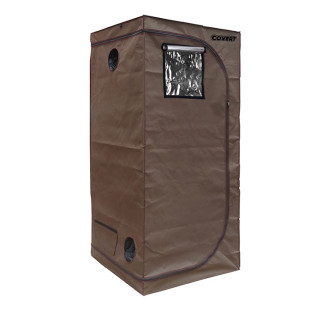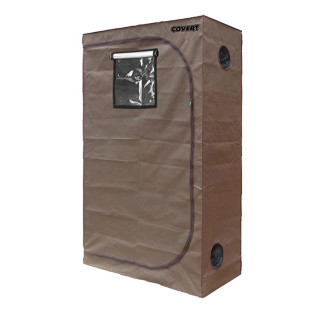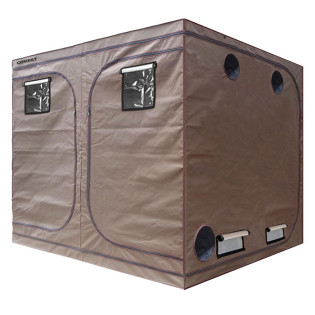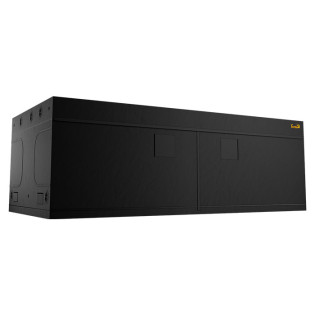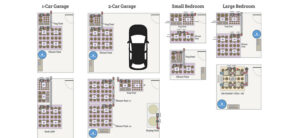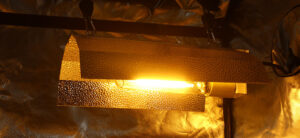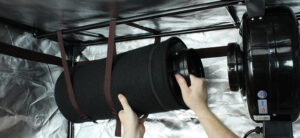
With so many out there, we decided to put together a grow tent buying guide to help you setup your indoor grow on the right foot.
Grow tents are an excellent solution for those wanting an indoor garden but don't want to devote an entire room or construct new walls to enclose a grow space.
With a rigid tent frame and a fabric outer cover, a grow tent is easy to setup and will keep your garden contained enabling atmosphere and lighting control as well as a bit of privacy.
Unlike grow cabinets, however, tents are not completely secure or stealthy, as they use simple zippers to secure doors and windows vs locking handles on grow cabinets.
Now, let's take a look at the grow tents options we have at Hydrobuilder.
Grow Tent Buying Considerations
We are first going to list a few things you should consider when shopping for a grow tent.
The main factors into which tent is best for you are size, material, and style.
Grow Tent Size Guide

Be sure to carefully measure the length, width and height of the space you intend to set up the grow tent in.
The tent should be slightly smaller than the space to allow for easy setup and maintenance.
You will also need to consider what your gardening goals are, and what size tent will allow you to achieve them.
The real question you need to be asking is how many plants do you want to grow and how big do you want those plants to be?
The size of your plants greatly effects what tents you want to be looking at. Another consideration is if you want to start continuous harvesting or if you want to grow in distinct cycles.
Usually, continuous harvesters will often want one tent for vegging, another tent for flowering and possibly even a third tent for harvest curing and drying
Because plant strains and container sizes vary, the number of plants you can grow in each size of tent is subjective.
Some growers like to grow a larger number of smaller plants and harvest them more frequently, auto-flowering strains are good for this.
Others like to have a couple of plants and train them to grow very wide, this is known as the SCROG method.
Finally, others want to grow the largest plants possible and will have a smaller number of large plants.
Therefore our recommendations on plant counts for each size of tents are just that, a recommendation. Your actual plant count may vary.

It will help you determine which size is best for you based on how many plants you want to grow, your budget, etc.
Here is a quick guide to sizing your tent with how many plants you can grow:
- 2' x 2' Grow Tent - Great for mother plants (1-2 plants)
- 2' x 4' Grow Tent - Fits in most closets (2-4 plants)
- 3' x 3' Grow Tent - Ideal for people with a limited work area (2-4 plants)
- 4' x 4' Grow Tent - Perfect for the footprint of a 1000w HID or LED grow light (4-6 plants)
- 5' x 5' and 4’ x 8’ Grow Tents - Our most popular tent sizes (4-10 plants)
- 5’ x 9’ and 8' x 8' Grow Tent - Great for a spare bedroom, expect large harvests (9-16 plants)
- 10' x 10' Grow Tent - Another perfect size for a spare bedroom or in the garage. (12-18 plants)
- 8’ x 16’ and Larger Grow Tents - Requires large space and power amperage for lights (16-32 plants)
Tight on head height? Take a closer look at the shorty line in our video review:
Multiple Chambers vs Multiple Tents:

Lots of growers like to have two separate tents for vegging and flowering as we said earlier.
But some tents offer multiple chambers within a single tent for the same purpose.
These tents are incredibly convenient, containing chambers for propagation, vegging, and flowering.
This helps to keep everything more organized, but most of these tents have limited vegging space.
Because of this, we still recommend going with two separate tents to enable growing larger plants for bigger yields.
You can use a special propagation tent for seedlings and clones, allowing them to veg here, and then have a tent just for harvest.
This will allow you to set up a perpetual harvest and have a constant supply of plants flowering.
Reflective Canvas Thickness:

What makes the thickness of the tent canvas important?
The greater the thread count, the stronger it is.
Durability can be an important factor for long-term use, especially if the tent will be moved often where accidental scuffs, punctures, and tears could occur.
All grow tents are light-proof, but those made with thicker material will resist wear and be slightly more insulated for heat and noise.
If your tent is in an indoor location you may not need as thick or rugged of walls as opposed to an outbuilding or shed.
Tent thickness varies from 1680D canvas thread count on down to 210D (the D in those measurements stands for denier and is a measure of the linear mass density of fibers).
The inner reflective of grow tents also varies by brand but the principle is the same for all of them, reflecting light off the interior tent walls helps to disperse light around the plant canopy. Here at Hydrobuilder, you'll find both standard duty and heavy duty grow tents - whatever you need, we've got it!
Weight Limit:

Grow tent frames are typically constructed of snap-together steel tubing with various materials used for corners and connection pieces.
Depending on the materials used for the poles and corner pieces a tent's weight limit may differ from another similarly sized tent.
Be sure to check the weight rating of the tent to ensure it can properly hold all of the equipment you intend to use.
If needed, additional support methods can be used if you are over the weight limit such as additional bars to spread weight out.
If in doubt play it safe and look to alternative methods of hanging or mounting the equipment in a location outside of the tent if possible (such as installing your carbon filter outside of the tent or on the floor of the tent).
Ducting Ports, Cord Ports and Windows

All grow tents will have a number of different sized ports through which you can run ventilation ducting and electrical cords.
The best tents will offer dual-cinching ports that allow you to completely block out any light coming through the port to ensure a light-proof tent.
Some tents also offer various windows and other mesh vents which can be useful for most gardeners.
Be sure to review the placement and size of the ports in each tent to ensure your equipment can be properly installed in the arrangement you have in mind.
Mesh vents are commonly only used during the vegging stage of growth where light leaks are not a problem.
When using a tent during the flowering stage a simple "u" bend in a section of ducting installed in a light-tight duct port can be used for an intake vent.
What Is The Best Grow Tent Brand?
For the price, Covert makes the best grow tents. Covert Grow Tents are the best value grow tent available, giving you everything you need and nothing you don't.
If you are just getting started, or you want to start growing indoors without breaking the bank, look no further than Covert.
Another popular option is Gorilla Grow Tent. These tents are the strongest in the industry, hence the name.
They are very expensive, which deters beginners, but they are very popular with more experienced growers who are able to invest more into their grow.
Secret Jardin is another great option, as these grow tents provide a unique look and are known for their multi-chamber look.
Covert Grow Tents

Consider a standard 5'x5' Covert Grow Tent (formally High Rise Grow Tent).
You can grow anywhere from 2 extra large plants up to 16 small plants (see figure 1).
If you are growing very small plants such as herbs or seedlings you can have several layers of plants on rigid wire shelves in order to maximize vertical space inside the tent. Shelves are also useful when it comes time to dry your crop.
There are a number of removable suspended mesh drying racks that will fit inside your tent in order to utilize the tent for the entire growing cycle.
The mesh allows for even drying conditions. Many of these collapse down for ease of storage when drying is finished.
Gorilla Grow Tents

Some tents, such Gorilla grow tents, also support height adjustment. This allows you to add additional vertical feet to a tent and increase yield (see figure 2).
Gorilla Grow Tents are the first ever height adjusting grow tent. Grow plants up to a foot taller (or more with additional extensions) and yield up to 33% more!
Gorilla Grow Tents are one of the most popular grow tent brands on the market today.
They are incredibly strong and known for their 'Heavy Duty' line, which boasts the thickest fabric and frame on the market. But, most growers really don't need this much strength. You will be just fine with a more budget-friendly alternative like Covert, which still uses premium inputs for the highest-quality tent possible.
But, Gorilla stands out with their Shorty line. The GGT Shorty line is for those with height-challenged spaces, as these come standard at just under 5' tall.
Another reason many growers love Gorilla Grow Tents is because of all the customization and accessories you have access to. With cool additions like height extension kits, high CFM kits, heavy-duty trellis, and more, these are awesome tents for those who have the budget for them.
Grow Tents vs Grow Cabinets: Which Is Better?

Many indoor gardeners have considered the option of purchasing a tent against a more solid and “stealthy” cabinet.
Many grow cabinets are available that look just like a traditional storage or file cabinets and as a result are much less conspicuous. If discretion is an absolute requirement, it’s hard to beat a cleverly designed cabinet.
However, most gardeners will benefit much more from the additional growth space offered by a grow tent and can find alternative ways of keeping the grow operation discrete.
We highly recommend grow tents over cabinets whenever possible as most growers will be happier with the potential yields.
Learn more about the difference between tents and cabinets.
Why Should You Grow in a Grow Tent?
When you embark on your growing journey there are numerous choices you will be faced with.
From equipment to set up and placement of the garden, the possibilities may seem endless.
Once the choice has been made to grow indoors, whether that be a desire for a year-round garden or discretion, one must decide between purchasing a predesigned grow tent or performing an overhaul on a room to fit their needs.
For most hobby growers the overhaul of an entire room in their house is not practical and would be a daunting, expensive, and sometimes unnecessary project.
Here are the top 5 reasons our customers choose a grow tent for their indoor grow.
Grow Tents Give You Total Control of the Growing Environment
Grow tents are enclosed spaces that are designed specifically for growing.
There are a lot of environmental factors that go into growing strong and vigorous plants.
You have to control your temperature, humidity, light schedule and light intensity, ensure there is proper air circulation and that new air is always being introduced, and on we go.
As you become a more experienced gardener, you’ll become a lot more comfortable not only controlling these factors but manipulating them to grow bigger and better plants.
But many new to growing indoors struggle with just trying to keep their environmental factors stable.
Without a doubt, the best reason to grow with a grow tent is they are designed to make creating and controlling these environmental conditions easy.
Grow Tents Help You Avoid Pests and Infestations
The grow tents enclosed design keeps unwanted pests, such as aphids, flies and spider mites, at bay. Any outdoor grower will tell you how easy it is for pests to infect your plants and how difficult it is to get rid of them.
Provided the plants and equipment you use are clean, you should be fine.
Grow Tents are Energy Efficient
The mylar interior increases the reflective surface area in your grow tent,maximizing the performance of your light.
This design ensures that no precious light is wasted and your plants are receiving the best light possible.
Grow Tents are Versatile and Adaptable
Grow tents are an excellent way to utilize an area without completely transforming it. You can grow in your garage or spare bedroom with ease.
You can completely break down your grow space once you have completed your cycle.
Tents are also extremely adaptable when flipping from veg to flower. They also make moving from soil to hydroponics incredibly simple.
Grow Tents Are The Fastest And Easiest Way To Start Growing Indoors
If you asked any gardener if it was harder to grow plants inside or outside, the majority would overwhelmingly say inside.
That’s not to say growing indoors doesn’t come with incredible benefits, nor does it mean that outdoor plants are always superior.
Plants have evolved to thrive in an outside environment. When you’re growing indoors, you’re essentially creating a mini-environment in your house that looks like your outside environment and this creates more room for errors.
There is no better way to create your mini-artificial environment than by starting with a grow tent that is designed for all the factors that will go into creating your indoor environment
Grow Tent Kits
If you are just getting started growing, you will be best with one of our grow tent kits.
These include everything you need to start growing indoors, including:
- Grow tent
- Grow lights, hangers, and timer
- Growing method: hydroponics vs traditional pots
- Ventilation system
- Growing supplies
If you are looking to purchase a complete package, you should check out our list of the best grow tent kits on the market this year.
How To Set Up Your Grow Tent
Before you start putting your tent together, visualize what your growing space is going to look like. Are you growing in a closet?
Your garage?
Check out our post on common grow room design examples to get you started!
Basic Grow Tent Supplies
- Power strip with surge protection
- Hanging equipment
- Grow lights and light timer
- Temperature gauge
- Plants and grow media
- Ventilation and odor control
Unpacking and assembling your grow tent
Grow tents are fairly easy to set up and will come with instruction on how to easily do so.
You can easily find videos online if you need additional help. For larger tents, it’s recommended to have someone there to help you out.
Basic outline and tips for easy installation:
- Lay your tent flat out on the ground
- Locate the bottom of the tent
- Separate your long and short poles
- Assemble the bottom poles first, making a square, and place it within the bottom of the tent
- Now that you have your base, connect poles that stand upright to your bottom structure
- Attach your top poles to form your complete pole structure/skeleton of the tent
- Last, carefully roll the tent up and over the pole structure and zip it up
- When lifting your tent over the poles, hold down on the poles because they are lightweight and will lift up with the tent
Ventilation and Odor Control tips
You need to set up a ventilation system in your grow tent.
A properly set up ventilation system will control CO2, temperature, humidity, and oxygen which are all vital environmental factors that greatly affect plant growth and development.
A common ventilation system for grow tents will have: an odor control unit, ducting, an extraction fan, and an intake fan (optional for smaller tents).
As noted above, the majority of our grow tents will tell you the recommended CFM rating for the tents size.
To find your CFM requirements, multiply W x L x H of your grow tent. This will give you the volume or cubic feet of the tent. You will use this number as your reference number and you will not want a fan with a lower CFM rating.
We recommend doubling the cubic feet of your tent to get your extraction fan’s CFM rating – especially when using carbon filter as they may lower your extraction fan’s moving capability by 30%.
So a grow tent that is 60 cubic feet will need an extraction fan that has a CFM rating of 120. If you choose to use an intake fan, we recommend going the next volume size down or 70% of your extraction fan.
Again, this is the preferred rate based on removing all the air in a grow tent in just one minute, some others will recommend a more leisure rate between 1-5 minutes.
Check our our complete guide on setting up your grow tent ventilation.
Here, you will be able to compare brands, styles, and sizes. This section also contains more information on grow tent growing!
If you have any questions about growing in a tent, our expert growers are available to answer any questions you have at 888-815-9763.





